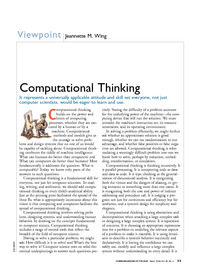 Zusammenfassungen
Zusammenfassungen
 Seven years ago, Jeannette Wing’s hugely influential article, "Computational Thinking," argued that to reading, writing, and arithmetic, we should add computational thinking to every child’s analytical ability. The essence of computational thinking is in ‘thinking like a computer scientist’ when confronted with a problem. Among other things, this entails thinking logically and algorithmically--understanding not only notions of flow of control in a programmatic solution but also how to systematically break down a problem and then compose an algorithmic solution.
Seven years ago, Jeannette Wing’s hugely influential article, "Computational Thinking," argued that to reading, writing, and arithmetic, we should add computational thinking to every child’s analytical ability. The essence of computational thinking is in ‘thinking like a computer scientist’ when confronted with a problem. Among other things, this entails thinking logically and algorithmically--understanding not only notions of flow of control in a programmatic solution but also how to systematically break down a problem and then compose an algorithmic solution. Bemerkungen
Bemerkungen
 The rapid infusion of so many enthusiastic newcomers who were
unfamiliar with the long prior history of CT led to considerable confusion
about definitions and learning objectives of CT. Some invented new CT
frameworks for K–12 schools from scratch, imperfectly reinventing ideas
that had been discussed for decades, omitting important ideas, confusing
CT with the use of applications, and incorporating into their dogma some
serious misconceptions about computing and algorithms.
The rapid infusion of so many enthusiastic newcomers who were
unfamiliar with the long prior history of CT led to considerable confusion
about definitions and learning objectives of CT. Some invented new CT
frameworks for K–12 schools from scratch, imperfectly reinventing ideas
that had been discussed for decades, omitting important ideas, confusing
CT with the use of applications, and incorporating into their dogma some
serious misconceptions about computing and algorithms. Jeannette Wing’s 2006 essay on computational thinking launched a new
wave in the movement to provide computing courses for all students in K–
12 schools. The term computational thinking resonated and inspired action
where literacy and fluency had not. Wing mobilized significant resources at
the NSF to bring a large number of researchers into investigations of CT in
education, to train a large number of teachers for teaching CT, to mobilize
private organizations to produce K–12 curriculum recommendations for CT,
and to develop a new Advanced Placement curriculum and exam on
computing principles. Wing’s essay became one of the most cited in
computing education, a rallying point in a global movement to penetrate CT
into K–12 education.
Jeannette Wing’s 2006 essay on computational thinking launched a new
wave in the movement to provide computing courses for all students in K–
12 schools. The term computational thinking resonated and inspired action
where literacy and fluency had not. Wing mobilized significant resources at
the NSF to bring a large number of researchers into investigations of CT in
education, to train a large number of teachers for teaching CT, to mobilize
private organizations to produce K–12 curriculum recommendations for CT,
and to develop a new Advanced Placement curriculum and exam on
computing principles. Wing’s essay became one of the most cited in
computing education, a rallying point in a global movement to penetrate CT
into K–12 education. The current computational thinking (CT) movement in computing education
began in 2006 when Jeannette Wing declared that “computational thinking
is a fundamental skill for everyone, not just for computer scientists” and that
“everyone can benefit from thinking like a computer scientist” (Wing, 2006,
2010). Her declaration came at a time when everything was being digitized and
people were finding themselves in a world where algorithms and computing
machines made many decisions that affected their work and their lives every
day. The unfamiliar logic of computing was bringing great benefits, such as
connectivity, along with great worries, such as loss of jobs to automation. Wing
called on educators to help everyone learn how computing works, how they
can harness it in their own lives, and when they can trust it.
The current computational thinking (CT) movement in computing education
began in 2006 when Jeannette Wing declared that “computational thinking
is a fundamental skill for everyone, not just for computer scientists” and that
“everyone can benefit from thinking like a computer scientist” (Wing, 2006,
2010). Her declaration came at a time when everything was being digitized and
people were finding themselves in a world where algorithms and computing
machines made many decisions that affected their work and their lives every
day. The unfamiliar logic of computing was bringing great benefits, such as
connectivity, along with great worries, such as loss of jobs to automation. Wing
called on educators to help everyone learn how computing works, how they
can harness it in their own lives, and when they can trust it. Dieser wissenschaftliche Zeitschriftenartikel erwähnt ...
Dieser wissenschaftliche Zeitschriftenartikel erwähnt ...
 Dieser wissenschaftliche Zeitschriftenartikel erwähnt vermutlich nicht ...
Dieser wissenschaftliche Zeitschriftenartikel erwähnt vermutlich nicht ... 
 Nicht erwähnte Begriffe | dining philosophers problem, Informatik-Didaktik, Informatik-Unterricht (Fachinformatik) |
 Tagcloud
Tagcloud
 Einträge in Beats Blog
Einträge in Beats Blog
 3 Erwähnungen auf anderen Websites im Umfeld von Beat Döbeli Honegger
3 Erwähnungen auf anderen Websites im Umfeld von Beat Döbeli Honegger
 |  Computational Thinking: Artikel als Volltext ( Computational Thinking: Artikel als Volltext ( : :  , 50 kByte; , 50 kByte;  : :  2021-03-21) 2021-03-21) |
 Anderswo suchen
Anderswo suchen 
 Beat und dieser wissenschaftliche Zeitschriftenartikel
Beat und dieser wissenschaftliche Zeitschriftenartikel
Beat hat Dieser wissenschaftliche Zeitschriftenartikel während seiner Zeit am Institut für Medien und Schule (IMS) ins Biblionetz aufgenommen. Beat besitzt kein physisches, aber ein digitales Exemplar. Eine digitale Version ist auf dem Internet verfügbar (s.o.). Es wird häufig von anderen Objekten im Biblionetz zitiert. Beat hat Dieser wissenschaftliche Zeitschriftenartikel auch schon in Blogpostings erwähnt.










 Biologie
Biologie Computer
Computer Denken
Denken Effizienz
Effizienz machine learning
machine learning Mathematik
Mathematik Mensch
Mensch Problem
Problem Programmieren
Programmieren Statistik
Statistik

 199
199 

 Biblionetz-History
Biblionetz-History